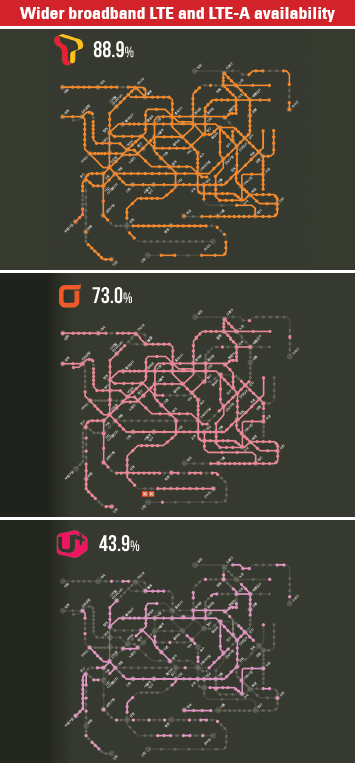Fast subway connections

Source: Playwares
“It is less frustrating to play videos or download data in the subway after switching to wider broadband LTE,” said Park.
For the 7 million persons who use the subway to get to work, a fast data network is no small thing. That led the three mobile carriers to take their intense competition underground on their so-called wider broadband long-term evolution (LTE) and LTE-Advanced services.
LTE-A doubles LTE data flow from 75 megabits per second to 150 megabits by connecting two bandwidths, whereas wider broadband LTE doubles data flow by widening a single bandwidth. For subways in the greater Seoul area - including Incheon and parts of Gyeonggi - the nation’s largest carrier, SK Telecom, was found to have built the biggest network for both wider broadband LTE and LTE-A. KT was next, followed by LG U+.
According to Playwares, an electronic devices and telecommunications service review website on Monday, about 88.9 percent of subway stations had wider broadband LTE and LTE-A services, provided by SK Telecom, available in the greater Seoul area. Regular LTE service was available at the rest of stations. The company commercialized the LTE-A technology for the first time in the world in June and launched the wider broadband LTE in September after obtaining extra bandwidth at a government-hosted frequency auction in August.
Playwares estimated the speed of the two services provided by all three mobile carriers at 460 subway stations on all lines Oct. 29-30. The assessment used the Galaxy Note 3 and S4, two devices compatible with both wider broadband LTE and LTE-A. While wider broadband LTE works on all LTE-enabled smartphones, LTE-A service works on only a few of the most recent models.
KT’s wider broadband LTE was accessible at 73 percent of stations, while the rest of the stations enabled regular LTE service, thanks to the extra 15 megahertz of bandwidth adjacent to its existing spectrum.
“Our wider broadband LTE was estimated to be better quality at an assessment done by another assessment company, Benchbee,” a KT employee said. “KT could implement the wider broadband LTE throughout the city a lot faster than the competitors, thanks to a tightly woven network in our frequency bandwidth near 1.8 gigahertz.”
LG U+, which hasn’t finished building a wider broadband LTE network in Seoul, detected LTE-A service underground at 43.9 percent of subway stations, while regular LTE was offered at the rest.
The company is preparing the latest broadband LTE network in the newly obtained bandwidth near 2.6 gigahertz. LG owns about a 5 megahertz wider frequency bandwidth compared to its two competitors at 35 megahertz, but it takes time for the company to establish base stations and radio repeaters. “We will offer better quality service than the competitors by the end of the year when we finish building a wider broadband LTE network throughout Seoul and the greater Seoul area,” an LG U+ employee said.
BY PARK SU-RYON [jiyoon.kim@joongang.co.kr]










with the Korea JoongAng Daily
To write comments, please log in to one of the accounts.
Standards Board Policy (0/250자)